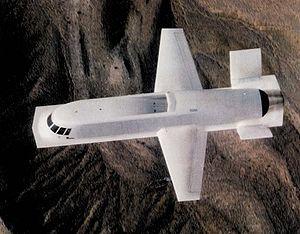Northrop Tacit Blue
| Northrop Tacit Blue | |
|---|---|
 Test flight of the Tacit Blue |
|
| Type: | Experimental Stealth - reconnaissance aircraft |
| Design country: | |
| Manufacturer: | |
| First flight: |
February 1982 |
| Commissioning: |
Flight tests ended in 1985 |
| Production time: |
Was never mass-produced |
| Number of pieces: |
2 |
The Northrop- built Tacit Blue , or "silent blue" in German, is a test aircraft of the US Air Force that was supposed to show that stealth reconnaissance aircraft can operate close to the front without being detected by the enemy radar. Tacit Blue has done a lot to understand stealth technology and was an important step in the development of the B-2 Spirit stealth bomber .
history
Assault Breaker
At the height of the Cold War , the superiority of the Warsaw Pact in tanks and ground forces was seen as a problem.
In December 1976, DARPA and the US Air Force initiated the Battlefield Surveillance Aircraft Experimental (BSAX) program, (part of Pave Mover, see below). The aim of BSAX was to develop an efficient stealth reconnaissance aircraft that was equipped with a low probability of intercept radar and other sensors. Thus, the aircraft should be able to fly close to enemy lines with a high probability of survival .
To fend off a possible attack by the Soviet Union on Central Europe, the "Assault Breaker" program was launched in 1978. The aim was to use long-range reconnaissance and precision-guided ammunition to destroy ground targets far behind enemy lines. The program laid the foundations for all modern airborne weapons systems used in the conflicts of the 21st century.
In it, LANTIRN containers were developed as a navigation and targeting system for low-level flight operations ( Messerschmitt-Bölkow-Blohm developed the Vebal Syndrome pod for this purpose), as well as cruise missiles that were supposed to bring intelligent submunitions to a Soviet tank formation at low altitude and release them above it. The cruise missiles never went into production, the submunitions were later integrated into the MLRS as Brilliant Anti-Tank (BAT) . Another development concerned ammunition containers for warplanes, which were supposed to release a swarm of intelligent homing missiles with millimeter-wave radar seekers in the target area. The development was advanced by Hughes with the Wasp "Minimissile", but was discontinued because of excessive costs. The principle was taken up again with the MBDA Brimstone . The CBU-97 Sensor Fuzed Weapon also has its origins in the Assault Breaker program.
Pave movers
Here, round shapes and a low-probability-of-intercept (LPI) radar were used for the first time . The central element was pave mover. A powerful side-looking airborne radar with electronic beam swiveling was mounted on a General Dynamics F-111 in order to be able to locate Soviet tanks at a distance of over 100 kilometers far behind the front line. Since the computing power of the computers used at the time was low, the raw data from the radar was sent to a ground station for analysis via a powerful data link. With advances in microelectronics it became possible to accommodate computers and personnel in an aircraft - the E-8 Joint STARS (Surveillance and Target Attack Radar System) was created.
Tacit Blue
Information on the Tacit Blue Project was released on April 30, 1996 by the United States Department of Defense . It was announced that the Assault Breaker program also had a "black" part. The project was intended to demonstrate the effectiveness of stealth aircraft in frontline operations. Tacit Blue was developed to take over monitoring tasks behind the front and to transmit target information to the ground in real time. Since the viability of the radar platform was in doubt, Northrop developed the Tacit Blue stealth aircraft, which was equipped with a low-probability-of-intercept radar.
Use and whereabouts
It was first used in February 1982. A total of 135 flights were carried out within three years. Tacit Blue was mothballed in 1985 after about 250 flight hours. Today the aircraft can be viewed at the National Museum of the United States Air Force at Wright-Patterson Air Force Base near Dayton , Ohio .
The serial number is unknown. Although a second copy was also built as a replacement, only one aircraft flew.
construction
Tacit Blue, nicknamed "The Whale", had trapezoidal wings and a V- tail . A single air inlet on the top of the fuselage was enough to supply the two turbofan engines. Tacit Blue introduced a quadruple redundant digital fly-by-wire flight control system. With the Tacit Blue, faceting of the surface was dispensed with for the first time. The increased computing power of the computer made it possible to continuously curve the surface and still calculate the reflections according to Huygens' principle , which was not possible when the Lockheed F-117 was developed.
The construction costs were around 165 million US dollars.
Technical specifications
| Parameter | Data |
|---|---|
| crew | 1 |
| length | 17 m |
| span | 14.7 m |
| height | 3.2 m |
| Flight mass | 13,606 kg |
| Top speed | 462 km / h |
| Service ceiling | 9144 m |
| Engines | 2 × Garrett ATF3 -6 turbofan engines with 24 kN thrust each |
| Thrust-to-weight ratio | 0.36 |


